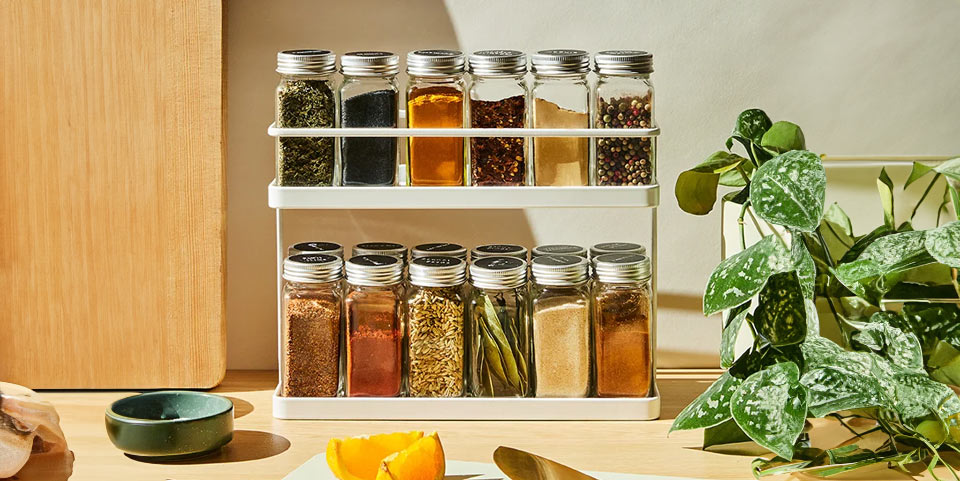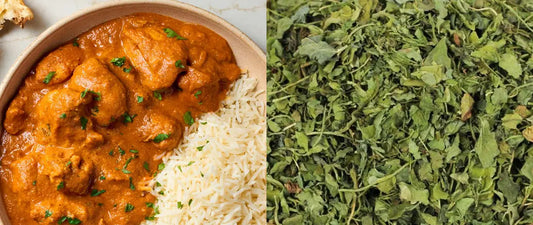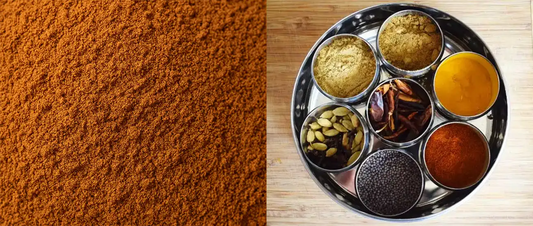
How to Store Indian Spices: 7 Simple Tips
Table of Contents
Spices are the heart and soul of countless international cuisines, adding flavour and aroma to our favourite dishes. However, to keep your spices in top-notch condition, it's crucial to know how to store Indian spices. In this article, we'll explore the science behind spice storage and provide you with seven practical tips to ensure your spice collection remains fresh and flavourful. Not only will these tips save you money, but they'll also reduce food waste, ensuring your meals are always bursting with flavour.
Why Proper Spice Storage Matters
Proper storage matters because it can make the difference between a bland meal and a delicious one. The science here is simple: spices are highly susceptible to four factors—light, heat, air, and moisture. These can quickly degrade the quality of your spices and diminish their flavour.

7 Simple Spice Storage Tips
Here are 7 tips on how to maximise the freshness of your spices:
-
Keep Spices in Airtight Containers:
Oxygen is a major factor in the degradation of spices. When spices are exposed to oxygen, oxidation occurs, leading to the breakdown of their volatile compounds. Storing spices in airtight containers minimizes their exposure to oxygen, preserving their flavour and aroma.
-
Store Spices in a Cool, Dark Place:
Heat and light can accelerate chemical reactions within spices. Many of the volatile compounds responsible for the flavour and aroma of spices are sensitive to heat and light. Storing spices in a cool, dark place reduces the rate of these reactions, helping to maintain their quality over time.
-
Avoid Heat Sources:
Heat can cause spices to release their volatile compounds more rapidly. When spices are exposed to heat sources, such as stoves or ovens, the chemical reactions that break down their aromatic compounds are accelerated. Storing them away from heat sources ensures their longevity.
-
Keep Spices Away from Moisture:
Moisture is the enemy of spices because it can lead to clumping (also known as caking), and the growth of molds and bacteria, ruining their quality. Store spices away from areas with high humidity, like near the sink or dishwasher. If your spices do become clumpy, use a clean, dry utensil to break them apart, and consider adding a moisture-absorbing packet to the spice container to prevent future clumping.
-
Buy Whole Spices and Grind as Needed:
Whole spices, such as whole bay leaves or cinnamon sticks, tend to retain their flavour and aroma longer because their protective outer layers shield them from oxygen. Consider buying whole spices and grinding them as needed for your recipes to enjoy a more robust flavour profile.
-
Labelling and Dating:
Over time, spices can lose their potency, and it's important to know when they were purchased. Labelling and dating containers help you keep track of the freshness of your spices, allowing you to use them when they are at their peak flavour.
-
Regularly Rotate Your Spice Collection:
Spices have a shelf life. Ground spices generally last about 1-2 years, while whole spices can last 3-4 years. However, freshness can vary depending on storage conditions. To ensure you're using fresh ones, rotate your collection regularly. Check the expiry dates, and if there isn't one, use the "sniff test" to determine freshness.

How To Tell if Your Spices Have Expired
Spices don't truly expire in the traditional sense, but they do lose their flavour and potency over time. This is because spices are made up of volatile compounds, which are easily broken down by light, heat, air, and moisture.
Here are some tips on how to tell if your spices have expired:
- Smell:
- Taste:
- Color:
- Texture:
If a ground spice is clumpy or caked, it's likely too old to use. This is because moisture has caused the spice to clump together.
How Long Do Spices Last?
Dried herbs and spices are at their peak flavor and aroma during the first few years after they are dried. Dried herbs typically last for 1 to 3 years, while dried spices can last for up to 4 years, especially if they are whole. Ground spices tend to lose their flavor more quickly, so it is best to use them within 1 year of purchase.
Here's a table with the most popular Indian spices and their shelf life, including a column for ground spices and whole spices:
| Spice | Ground | Whole |
|---|---|---|
| Allspice | 1-2 years | 3-4 years |
| Amchoor | 1-2 years | 3-4 years |
| Asafoetida | 1-2 years | 3-4 years |
| Bay leaves | 1-2 years | 3-4 years |
| Black pepper | 1-2 years | 3-4 years |
| Cayenne pepper | 1-2 years | 3-4 years |
| Chilli powder | 1-2 years | 3-4 years |
| Cinnamon | 1-2 years | 3-4 years |
| Cloves | 1-2 years | 3-4 years |
| Coriander | 1-2 years | 3-4 years |
| Cumin | 1-2 years | 3-4 years |
| Fennel seeds | 1-2 years | 3-4 years |
| Garam masala | 1-2 years | 3-4 years |
| Garlic powder | 6-12 months | 1-2 years |
| Ginger | 6-12 months | 1-2 years |
| Mustard seeds | 1-2 years | 3-4 years |
| Nutmeg | 1-2 years | 3-4 years |
| Onion powder | 6-12 months | 1-2 years |
| Oregano | 1-2 years | 3-4 years |
| Paprika | 1-2 years | 3-4 years |
| Red pepper flakes | 1-2 years | 3-4 years |
| Salt | Indefinitely | Indefinitely |
| Turmeric | 1-2 years | 3-4 years |
Read more: 10 Must-Have Indian Spices for Your Kitchen.
Spice Storage Do's and Don'ts
To wrap it all up, here's a quick recap of the do's and don'ts of spice storage:
Do's:
- Use airtight containers.
- Keep spices away from light, heat, air, and moisture.
- Label and organize your spices.
- Grind whole spices as needed.
- Regularly check and replace old spices.
- Store seasonal and specialty spices carefully.
Don'ts:
- Don't store spices near the stove or dishwasher.
- Don't leave spice containers open.
- Don't buy ground spices in bulk if you won't use them quickly.
- Don't forget to label your spices; you'll thank yourself later.

By following these spice storage tips, you'll ensure that your meals are consistently delicious. Proper spice storage is a small investment in time and effort that pays off in big, flavourful dividends.
Have a question? leave a comment below.


